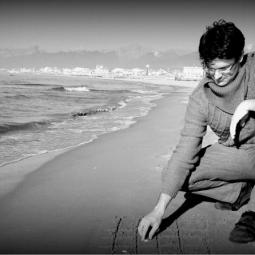Biography
Simone Domeniconi was born at Carpi (MO) on May 19th, 1972.
da sinistra Simone, al centro lo storico e critico d'arte Giovanni Faccenda, a destra il critico d'arte Lodovico GierutHis gift for art and poetry dates back to his secondary-school days and has been recognized through such prestigious awards as the “San Domenichino International Prize” and the “Apuan Alps Prize”.
Thanks to his lively versatility, Domeniconi worked as the artistic director and anchorman in the “Road Café” television programme (“Antenna 3” Channel). At the same time, he set about painting and writing, organizing exhibitions, associating with artists and intellectuals. Among his acquaintances are Robert Carroll, an American painter of international renown (quadrennial exhibition in Rome in the early 1960s), and Fabio Grassi, a drawing master and teacher at the Art Academy in Carrara, under whose guidance Domeniconi improved his pictorial skills.
As far as painting is concerned, he first focused on the figurative dimension, experimented with mixed materials and techniques and subsequently devoted his artistic research to the study of a conceptual aesthetics relating to the game of chess.
My Poetry
CAPABLANCA - MARSHALL, New York 1909 - Tecnica mista su tela If I were to talk about my initiation to art, I would quote the opening lines of Pablo Neruda’s “La poesía”: “Y FUE a esaedad … Llegó la poesía / a buscarme” (“It was right at that age … Poetry came / In search for me”). Poetry started walking on tiptoe into my life when I was a child. Even before writing verse, I knew I was a Poet. It felt like a shiver coming down with the night with its smell of laundry and smoke.
I soon discovered that Poetry was rooted in sound. Its song rose as my soul drew breath and endeavoured to fill the sounds of words, making verse “resound”. Dropping the pen to seize the paint-brush was a painful choice, but the wish to put myself to the test in the world of figurative arts was too strong. I opted for an old-fashioned route, “serving my apprenticeship” with painters or academy teachers.
The path trodden was different from that of many other artists, since I was burning with the fire of passion and took impracticable roads. I studied the history of art because I thought it was important to know what had been done before I came. Luckily I was never “tempted” to indulge in mere provocation, as instead the current trend goes, since I thought and still think that provocation often conceals a lack of talent. I went through a figurative and then an experimental period up to my peculiar probing into the game of chess, which I have been fond of since I was a child.






